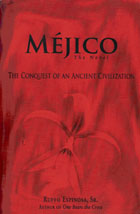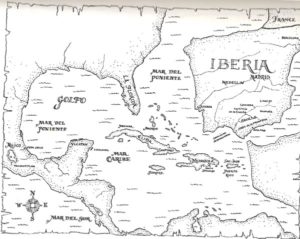Good Reading
This is the beginning of the end….
 Ruffo Espinosa, Sr., the author of this remarkable historical novel, was born in Mexico in 1907, although he spent most of his adult life in the United States. He studied both at the University of Southern California and the University of Arizona, and held a bachelor of arts in English and a doctorate in Law. Throughout his life he remained fascinated by the “the conquest of Mexico.”
Ruffo Espinosa, Sr., the author of this remarkable historical novel, was born in Mexico in 1907, although he spent most of his adult life in the United States. He studied both at the University of Southern California and the University of Arizona, and held a bachelor of arts in English and a doctorate in Law. Throughout his life he remained fascinated by the “the conquest of Mexico.”
The short “Biography of Ruffo Espinosa” at the back of the book says that “As a champion for the underdog, Mr. Espinosa felt that history unjustly dishonors Spanish conquistador, Hernán Cortés; Aztec emperor, Moctezuma; and Olutla Princess, Malintzín, who had been branded a prostitute and traitor by Mexicans for her assistance to Cortés in facilitating the conquest of the Aztec civilization. After researching literature in the Nahuatl and Spanish languages, Mr. Espinosa discovered that the three characters had a glorious story to tell. He traveled extensively throughout Mexico and Spain to gather materials. Finally, after more than forty-five years, he wrote his novel Méjico….”
And a fine novel it is! When I first picked up Méjico: The Conquest of an Ancient Civilization and saw that it was 672 pages long, I thought, even though the subject fascinates me, that this book – by someone totally unknown to me on top of it – would be difficult for me to finish. How wrong I was. I began on a Saturday afternoon, read late into the night, completely absorbed, read in whatever time I could find on Sunday, and still absorbed finished the novel on Monday… not wanting it to be over!
 The Foreword says it clearly – “This epic story of love, hatred, religion, greed, war, pageantry, and honor is artfully woven by the author between three primary participants in the conquest. Hernán Cortés, who came to conquer an empire in search of wealth and fame, found a magnificent people led by Emperor Moctezuma. The emperor accepted the conquistador because he thought Cortés was the Plumed Serpent, Quetzalcoatl, returned to fulfill the prophecy of his fathers.
The Foreword says it clearly – “This epic story of love, hatred, religion, greed, war, pageantry, and honor is artfully woven by the author between three primary participants in the conquest. Hernán Cortés, who came to conquer an empire in search of wealth and fame, found a magnificent people led by Emperor Moctezuma. The emperor accepted the conquistador because he thought Cortés was the Plumed Serpent, Quetzalcoatl, returned to fulfill the prophecy of his fathers.
“The princess, Malintzín, became interpreter for Cortés and the Aztecs. The intelligence, strength, beauty, and character of this young woman gave Cortés access to all the secrets of this New World. History has branded her a traitor when it was her love for her people, her country, and her faith in Quetzalcoatl that brought her to Cortés.
“The last emperor of the Aztecs, Cuauhtémoc, was valiant and courageous in his vain efforts to unify his people against the conquistadores. With him died the Aztec civilization and the Indian hope for the future.”
(Note that the Princess Malintzín (in Nahuatl “tzín” denotes nobility) in other texts is often called Malinche or La Malinche, although in Ruffo Espinosa’s book Malinche is a Nahuatl word that actually means “great warrior” and it is applied to Cortés and not Malintzín.)
Almost all of the novel is told through first person accounts – often of the same event seen through the eyes of Hernán Cortés and then through the eyes of Princess Malintzín – although their son, Martín Cortés, begins and ends the tale: “I pause to consider how I might best begin this story of three human beings [Malintzín, Cortés, and Cuauhtémoc] I have come to care for with a love surpassing any I have known through my long life. I was conceived at the zenith of their glory, and born in the dawn of their fall.”
The chapter headings indicate the method. Book One, Chapter I, for example, says “From the Oral Testament of Hernán Cortés”; Book Four, Chapter I, says “From the writings of Princess Malintzín.” Ruffo’s 45 years of preparation included study of the 75 sources listed in the Bibliography, books such as Bernal Díaz del Castillo (a comrade of Cortés), Historia verdadera de la conquista de Nueva Espana, written in 1568, and Codex chimalpopoca, written in Nahuatl, the language of the Aztecs, in the early 1500s.
The novel begins with the birth of Cortés in the town of Medellín in Extremadura province in Spain, “seven years before Christopher Columbus gave Ferdinand and Isabela the New World and my life its destiny.” His youth in the streets of Spain, fighting for his own honor and for the honor of his comrades, is a story in itself. Likewise, we soon hear, in her own words, the story of the young Princess Malintzín – not Aztec, incidentally, but Olutla – and we begin to understand the Aztec empire, where a few ruled over a confederacy of many different Indian groups, some of whom hated their Aztec rulers and the corrupt and power-mad priesthood that controlled Moctezuma, keeping him drugged each day and therefore willing to allow their insane demands for human blood.
Initially, the priesthood was satisfied with the blood of captured warriors, but then their high priest, Xicotl, decides that their god, the war god Huitzilopóchtli, “demands not masses of nameless human trash but persons of quality,” and he begins to sacrifice, presumably by lottery, the firstborn princes of the confederacy, in reality choosing the sons of those Indian groups they felt threatened the power of their Aztec priesthood.
Malintzín’s father, the non-Aztec King Malináli Tenepal, tells her: “This is the beginning of the end…. The priests hate the nobility because we are their only rivals. They own Moctezuma. We are now seeing the systematic extermination of Méjico’s noble families.”
Finally the Xicotl demands that the drugged Moctezuma himself sacrifice his best friend, Malintzín’s father, to please their war god Huitzilopóchtli, and, sadly, Moctezuma carries out the sacrifice himself, with the young princess in horror watching. The princess writes: “I looked at this monster, this predator who had ripped out my father’s living heart. He embraced and kissed me. Never had I felt such coldness and there never burned in a woman’s heart such a lust for revenge.”
This illustrates the conditions in the Aztec empire – on the brink of civil war – shortly before Cortés arrived at the shores of Méjico. At the same time, Quetzalcoatl, light-skinned, called “the Plumed Serpent,” a God of love and peace (actually born of God and a mortal woman) who had lived centuries earlier among the various groups in the confederation, had promised to return to the common people, and their astrologists had ascertained his second coming to be in 1518, about the time Cortés was landing.
Malintzín and Cortés discover each other and begin to fall in love. Cortés, the hardened soldier who had never found a woman he loved more than his horse Morito, begins to soften in his heart. After succumbing to his passion for Malintzín, he writes: “I had found with this innocent girl what I, in my wildest imagination, never believed to find in this world. This feeling was not only for Malintzín, but also for the beauty and mystery of the Méjico she was leading me to see.” Malintzín’s reaction: “I could not doubt that he was either Quetzalcoatl or his spirit….”
Cortés was immediately fascinated by Tenochtitlán, the magnificent Aztec capital (part of which is now Mexico City), but sickened at the human sacrifice, evidenced so clearly by the “skull rack, which contained over one hundred thousand human heads….” The city itself, Cortés writes, “was without a rival in beauty, comparable only to the Adriatic city of Venice. I was determined, with the clean conscience of a man and the blameless soul of a Christian knight to cleanse it of the blight of murder committed daily in the name of their gods.”
(Much later his son, Martín, ponders this: “Are Aztec priests tearing out human hearts any worse than Dominicans burning Indians and Spanish alike for reasons no one can know for certain?”)
Like the books in the ancient library at Tenochtitlán, the manuscript of Méjico: The Conquest of an Ancient Civilization could easily have been lost. The author, Ruffo Espinoso, Sr., succumbed to pancreatic cancer in 1987. Friends of the Espinoso family, author Mark W. Royston and his wife Doris, some years later read the book in manuscript and encouraged and guided the family to publish it. Last year, 2006, the book was published through iUniverse, Inc., almost twenty years after the author’s death.
As that Foreward mentioned, Méjico: The Conquest of an Ancient Civilization, is an “epic story of love, hatred, religion, greed, war,” the stuff of real literature. Read it!
Available from Amazon Books: Paperback

